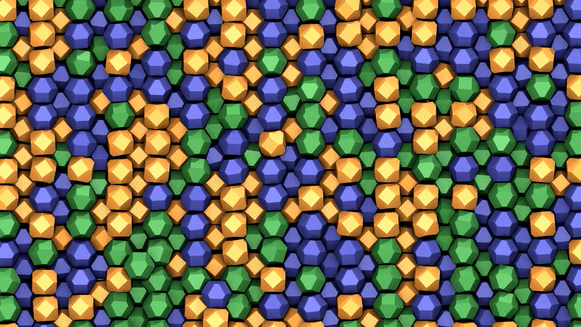Over the years I have had the great fortune of contributing to a broad range of research areas, starting from industrial biotechnology as an undergraduate, then molecular simulations of self assembly of nanoparticles as a PhD, and right now as a postdoc I am exploring interesting connections between network science, mechanics and biology.
Stimulus-Response of Materials
Disordering and Ordering of Monodisperse Spheres
In this forthcoming study, we explore how the presence of friction affects ordering in dense suspensions. In collaboration with Abhinendra Singh at CWRU, we explore the transitions in these systems using lubricated flow DEM simulations. In the simulation video, the red color represents the level of six-fold order. More details on the poster below.
Natural Modes and Phononic Bandgaps
This is an ongoing study of phononic modes of networked materials to exploit them for phononic bandgaps for application in elastic wave attenuation. The video shows several network modes at various frequencies using Lagrangian mechanics. I have also worked on translating this research into a new outreach demo.
Allostery in Disordered Networks
During my postdoc I have led multiple efforts to study allostery in the context of simplified models. In particular, I am interested in the learning and emergence of allostery in disordered networks. More details on the current directions under this project are included in the orientation poster.
Network Science for Soft Matter
During my postdoc, I have leveraged my interest in network science and graph theory to study phenomena in the context of soft materials, ranging from polymer mesophases , ion conducting networks, and dense suspensions. In most of these contexts, the network structure responds to a stimulus leading to changes in physical properties of the material.
Self Assembly of Polyhedral Nanoparticles
Diffusionless Transformations in Truncated Cubes
In this forthcoming study we explore the mechanism of diffusionless rotator-to-crystal transitions for truncated cubes, especially elucidating the role of lattice distortion.
Effect of Particle Anisotropy on Kinetics of Ordering Transitions
In this project we systematically explored the effect of particle anisotropy on phase behavior and kinetics of polyhedral nanoparticles, published in The Journal of Chemical Physics: Special Topic on “Nucleation: Current Understanding Approaching 150 Years After Gibbs.”
Direct Calculation of Interfacial Free Energy for Hard Particles
In a paper that is part theory and part simulation, we were able to explain the anomalies in disorder to order phase transitions in colloidal cubes.
Published in The Journal of Physical Chemistry virtual special issue “Carol K. Hall Festschrift” and was chosen for a supplementary cover art.
Anomalous Ordering Phase Transitions for Colloidal Cubes
Here we report a nuanced understanding of the disorder to order transition for colloidal cubes, indicating that the transformation has a bulk character borne out of an abundance of ordered domains
Nucleus Size Pinning
We improved upon the seeding method to determine nucleus geometry and calculate free energy barriers for cases where traditional rare event sampling is difficult. We also reveal a case of highly anisotropic nucleus being formed for hard gyrobifastagia.
Kinetics of Solid Nucleation for Truncated Cubes
In this work we calculate nucleation barriers for solid phases for various truncations of the cubes, tracing their trends as an interplay between local orientational order and facet alignment, the latter of which needed development of a new measure. Chosen as the main cover for Soft Matter.
For more projects, including undergraduate research, side-projects, and conference papers, please see my Google Scholar page.







